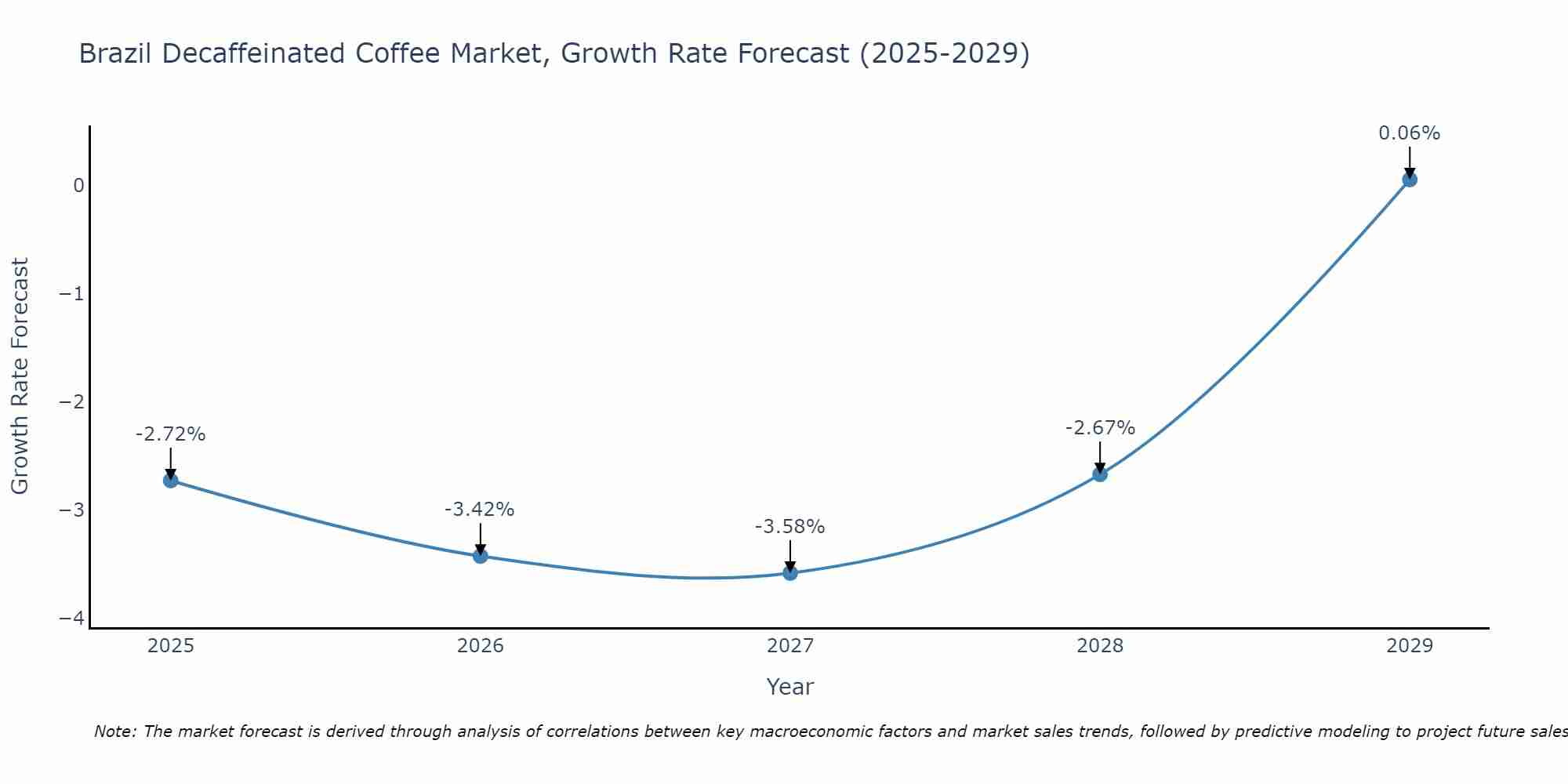Brazil Decaffeinated Coffee Market (2025-2031) | Companies, Forecast, Growth, Trends, Revenue, Share, Value, Industry, Analysis, Outlook & Size
Market Forecast By Product (Roasted, Raw), By Species (Arabica, Robusta), By Distribution Channel (Online, Offline) And Competitive Landscape
| Product Code: ETC177381 | Publication Date: Jan 2022 | Updated Date: Apr 2025 | Product Type: Market Research Report | |
| Publisher: 6Wresearch | Author: Ravi Bhandari | No. of Pages: 70 | No. of Figures: 35 | No. of Tables: 5 |
Brazil Decaffeinated Coffee Market Size Growth Rate
The Brazil Decaffeinated Coffee Market is projected to witness mixed growth rate patterns during 2025 to 2029. Commencing at -2.72% in 2025, growth builds up to 0.06% by 2029.

Brazil Decaffeinated Coffee Market Highlights
| Report Name | Brazil Decaffeinated Coffee Market |
| Forecast period | 2025-2031 |
| CAGR | 8.2% |
| Growing Sector | Food and beverage |
Topics Covered in Brazil Decaffeinated Coffee Market Report
Brazil Decaffeinated Coffee Market report thoroughly covers the market By Product, By Species, and By Distribution Channel. The market report provides an unbiased and detailed analysis of the ongoing market trends, opportunities/high growth areas, and market drivers which would help the stakeholders to devise and align their market strategies according to the current and future market dynamics.
Brazil Decaffeinated Coffee Market Synopsis
Brazil decaffeinated coffee market is experiencing a notable surge in demand, as health-conscious consumers increasingly seek out coffee options that offer the beloved taste and aroma of traditional coffee without the effects of caffeine. This shift is driven by a growing awareness of caffeine's potential impact on sleep patterns and overall health, coupled with Brazil's reputation for producing some of the world's finest coffee beans. Decaffeination processes have also improved, preserving the beans' original flavor profiles while removing caffeine, making decaf coffee more appealing than ever to both connoisseurs and casual coffee drinkers alike.
According to 6Wresearch, the Brazil Decaffeinated Coffee Market size is expected to grow at as CAGR of 8.2% during the forecast period 2025-2031. The Brazil decaffeinated coffee market is primarily driven by increasing health consciousness among consumers. Concerns about the negative effects of caffeine have led many to seek healthier alternatives, such as decaffeinated coffee. Moreover, changing consumer preferences towards premium and specialty coffee varieties, including decaffeinated options, have further fueled market growth. Additionally, strong government support through various initiatives has played a significant role in driving market expansion, ensuring a conducive environment for producers and exporters alike.
Despite its growth potential, the Brazil decaffeinated coffee market faces several challenges. High production costs associated with the decaffeination process pose a barrier for smaller producers, limiting their ability to enter the market. Furthermore, increased competition from other coffee-producing countries in the decaffeinated coffee segment puts pressure on prices, impacting profitability for Brazilian producers. Additionally, there remains a lack of consumer awareness about the benefits of decaffeinated coffee, necessitating costly marketing efforts that smaller producers may struggle to afford, hindering Brazil Decaffeinated Coffee Market Growth.
Brazil Decaffeinated Coffee Market: Leading Players
Nestle S.A., Kraft Foods Inc., Starbucks Corporation, The J.M. Smucker Company, and Eight O'Clock Coffee Co. are among the prominent players in the decaffeinated coffee Market in Brazil with significant presence in both domestic and international markets, these companies play pivotal roles in propelling the growth of this market segment.
Brazil Decaffeinated Coffee Market: Government Initiatives
The Brazilian government has been actively supporting the growth of the decaffeinated coffee market through various initiatives. One key strategy involves promoting sustainable farming practices, which benefit all coffee production, including decaffeinated coffee. Additionally, the government allocates funds for research and development specifically focused on improving decaffeination processes and developing new low-caffeine coffee bean varieties. Furthermore, incentives for exporters encourage Brazilian coffee producers to tap into the decaffeinated coffee market, ensuring its competitiveness on a global scale. Lastly, stringent quality control measures are in place to maintain the high standards of Brazilian decaffeinated coffee, boosting consumer trust and market demand.
Future Insights of the Market
The future of the Brazil Decaffeinated Coffee Industry appears promising, with growing consumer awareness and increasing demand for healthier beverage alternatives. Trends suggest a significant shift towards decaffeinated coffee, driven by consumers seeking to reduce caffeine intake without sacrificing the ritual and pleasure of coffee consumption. Advances in decaffeination processes, aimed at preserving flavor while eliminating caffeine, are likely to enhance product quality and variety. Furthermore, the rise in specialty coffee shops and the expansion of product offerings in supermarkets and online platforms are expected to further fuel the market's growth. Environmental sustainability and ethical sourcing will play critical roles in shaping consumer preferences, influencing producers to adopt more transparent and sustainable practices.
Market Segmentation by Product
According to Shivankar, Research Manager, 6Wresearch, the roasted decaffeinated coffee segment is expected to dominate the market. This can be attributed to the increasing popularity of specialty and premium coffee, as well as the growing demand for convenience products. Roasted decaffeinated coffee is also favored by many cafes and restaurants, further driving its growth in the market. However, the raw decaffeinated coffee segment is also expected to see significant growth in the coming years due to its use in specialty and craft coffee products. As consumer demand for high-quality and unique coffee experiences increases, there will likely be a continued growth in both of these product segments.
Market Segmentation By Species
There has been a growing demand for Robusta decaffeinated coffee due to its lower production costs and ability to withstand harsher weather conditions. This trend is expected to continue in the future as more producers look for ways to cut costs and increase sustainability in their farming practices. Additionally, with advancements in technology, the taste and quality of Robusta decaffeinated coffee have improved significantly, making it more appealing to consumers. This is expected to drive the growth of this species segment in the Brazil decaffeinated coffee market.
Market Segmentation By Distribution Channel
The online distribution channel segment is currently experiencing significant growth in the Brazil decaffeinated coffee market. This can be attributed to the increasing popularity of e-commerce and online shopping, as well as the convenience it offers to consumers. Online platforms also provide a wider reach for smaller producers who may not have access to traditional retail channels. However, the offline distribution channel still dominates the market, with brick-and-mortar stores and supermarkets being the primary source of decaffeinated coffee for consumers. Going forward, a combination of both distribution channels is expected to drive the growth of the Brazil decaffeinated coffee market.
Key Attractiveness of the Report
- 10 Years Market Numbers.
- Historical Data Starting from 2021 to 2024.
- Base Year: 2024
- Forecast Data until 2031.
- Key Performance Indicators Impacting the Market.
- Major Upcoming Developments and Projects.
Key Highlights of the Report:
- Brazil Decaffeinated Coffee Market Outlook
- Market Size of Brazil Decaffeinated Coffee Market, 2024
- Forecast of Brazil Decaffeinated Coffee Market, 2031
- Historical Data and Forecast of Brazil Decaffeinated Coffee Revenues & Volume for the Period 2021-2031
- Brazil Decaffeinated Coffee Market Trend Evolution
- Brazil Decaffeinated Coffee Market Drivers and Challenges
- Brazil Decaffeinated Coffee Price Trends
- Brazil Decaffeinated Coffee Porter's Five Forces
- Brazil Decaffeinated Coffee Industry Life Cycle
- Historical Data and Forecast of Brazil Decaffeinated Coffee Market Revenues & Volume By Product for the Period 2021-2031
- Historical Data and Forecast of Brazil Decaffeinated Coffee Market Revenues & Volume By Roasted for the Period 2021-2031
- Historical Data and Forecast of Brazil Decaffeinated Coffee Market Revenues & Volume By Raw for the Period 2021-2031
- Historical Data and Forecast of Brazil Decaffeinated Coffee Market Revenues & Volume By Species for the Period 2021-2031
- Historical Data and Forecast of Brazil Decaffeinated Coffee Market Revenues & Volume By Arabica for the Period 2021-2031
- Historical Data and Forecast of Brazil Decaffeinated Coffee Market Revenues & Volume By Robusta for the Period 2021-2031
- Historical Data and Forecast of Brazil Decaffeinated Coffee Market Revenues & Volume By Distribution Channel for the Period 2021-2031
- Historical Data and Forecast of Brazil Decaffeinated Coffee Market Revenues & Volume By Online for the Period 2021-2031
- Historical Data and Forecast of Brazil Decaffeinated Coffee Market Revenues & Volume By Offline for the Period 2021-2031
- Brazil Decaffeinated Coffee Import Export Trade Statistics
- Market Opportunity Assessment By Product
- Market Opportunity Assessment By Species
- Market Opportunity Assessment By Distribution Channel
- Brazil Decaffeinated Coffee Top Companies Market Share
- Brazil Decaffeinated Coffee Competitive Benchmarking By Technical and Operational Parameters
- Brazil Decaffeinated Coffee Company Profiles
- Brazil Decaffeinated Coffee Key Strategic Recommendations
Market Covered
The report offers a comprehensive study of the following market segments:
By Product
- Roasted
- Raw
By Species
- Arabica
- Robusta
By Distribution Channel
- Online
- Offline
Brazil Decaffeinated Coffee Market (2025-2031): FAQs
| 1 Executive Summary |
| 2 Introduction |
| 2.1 Key Highlights of the Report |
| 2.2 Report Description |
| 2.3 Market Scope & Segmentation |
| 2.4 Research Methodology |
| 2.5 Assumptions |
| 3 Brazil Decaffeinated Coffee Market Overview |
| 3.1 Brazil Country Macro Economic Indicators |
| 3.2 Brazil Decaffeinated Coffee Market Revenues & Volume, 2021 & 2031F |
| 3.3 Brazil Decaffeinated Coffee Market - Industry Life Cycle |
| 3.4 Brazil Decaffeinated Coffee Market - Porter's Five Forces |
| 3.5 Brazil Decaffeinated Coffee Market Revenues & Volume Share, By Product, 2021 & 2031F |
| 3.6 Brazil Decaffeinated Coffee Market Revenues & Volume Share, By Species , 2021 & 2031F |
| 3.7 Brazil Decaffeinated Coffee Market Revenues & Volume Share, By Distribution Channel, 2021 & 2031F |
| 4 Brazil Decaffeinated Coffee Market Dynamics |
| 4.1 Impact Analysis |
| 4.2 Market Drivers |
| 4.3 Market Restraints |
| 5 Brazil Decaffeinated Coffee Market Trends |
| 6 Brazil Decaffeinated Coffee Market, By Types |
| 6.1 Brazil Decaffeinated Coffee Market, By Product |
| 6.1.1 Overview and Analysis |
| 6.1.2 Brazil Decaffeinated Coffee Market Revenues & Volume, By Product, 2021-2031F |
| 6.1.3 Brazil Decaffeinated Coffee Market Revenues & Volume, By Roasted, 2021-2031F |
| 6.1.4 Brazil Decaffeinated Coffee Market Revenues & Volume, By Raw, 2021-2031F |
| 6.2 Brazil Decaffeinated Coffee Market, By Species |
| 6.2.1 Overview and Analysis |
| 6.2.2 Brazil Decaffeinated Coffee Market Revenues & Volume, By Arabica, 2021-2031F |
| 6.2.3 Brazil Decaffeinated Coffee Market Revenues & Volume, By Robusta, 2021-2031F |
| 6.3 Brazil Decaffeinated Coffee Market, By Distribution Channel |
| 6.3.1 Overview and Analysis |
| 6.3.2 Brazil Decaffeinated Coffee Market Revenues & Volume, By Online, 2021-2031F |
| 6.3.3 Brazil Decaffeinated Coffee Market Revenues & Volume, By Offline, 2021-2031F |
| 7 Brazil Decaffeinated Coffee Market Import-Export Trade Statistics |
| 7.1 Brazil Decaffeinated Coffee Market Export to Major Countries |
| 7.2 Brazil Decaffeinated Coffee Market Imports from Major Countries |
| 8 Brazil Decaffeinated Coffee Market Key Performance Indicators |
| 9 Brazil Decaffeinated Coffee Market - Opportunity Assessment |
| 9.1 Brazil Decaffeinated Coffee Market Opportunity Assessment, By Product, 2021 & 2031F |
| 9.2 Brazil Decaffeinated Coffee Market Opportunity Assessment, By Species , 2021 & 2031F |
| 9.3 Brazil Decaffeinated Coffee Market Opportunity Assessment, By Distribution Channel, 2021 & 2031F |
| 10 Brazil Decaffeinated Coffee Market - Competitive Landscape |
| 10.1 Brazil Decaffeinated Coffee Market Revenue Share, By Companies, 2024 |
| 10.2 Brazil Decaffeinated Coffee Market Competitive Benchmarking, By Operating and Technical Parameters |
| 11 Company Profiles |
| 12 Recommendations |
| 13 Disclaimer |
- Single User License$ 1,995
- Department License$ 2,400
- Site License$ 3,120
- Global License$ 3,795
Search
Related Reports
- Portugal Electronic Document Management Market (2025-2031) | Strategy, Consumer Insights, Analysis, Investment Trends, Opportunities, Growth, Size, Share, Industry, Revenue, Segments, Value, Segmentation, Supply, Forecast, Restraints, Outlook, Competition, Drivers, Trends, Demand, Pricing Analysis, Competitive, Strategic Insights, Companies, Challenges
- France Electronic Document Management Market (2025-2031) | Strategy, Consumer Insights, Analysis, Investment Trends, Opportunities, Growth, Size, Share, Industry, Revenue, Segments, Value, Segmentation, Supply, Forecast, Restraints, Outlook, Competition, Drivers, Trends, Demand, Pricing Analysis, Competitive, Strategic Insights, Companies, Challenges
- Portugal Occupational Health & Safety Services Market (2025-2031) | Strategy, Consumer Insights, Analysis, Investment Trends, Opportunities, Growth, Size, Share, Industry, Revenue, Segments, Value, Segmentation, Supply, Forecast, Restraints, Outlook, Competition, Drivers, Trends, Demand, Pricing Analysis, Competitive, Strategic Insights, Companies, Challenges
- Netherlands Occupational Health and Safety Services Market (2025-2031) | Strategy, Consumer Insights, Analysis, Investment Trends, Opportunities, Growth, Size, Share, Industry, Revenue, Segments, Value, Segmentation, Supply, Forecast, Restraints, Outlook, Competition, Drivers, Trends, Demand, Pricing Analysis, Competitive, Strategic Insights, Companies, Challenges
- Belgium and Luxembourg Facility Management Market (2025-2031) | Strategy, Consumer Insights, Analysis, Investment Trends, Opportunities, Growth, Size, Share, Industry, Revenue, Segments, Value, Segmentation, Supply, Forecast, Restraints, Outlook, Competition, Drivers, Trends, Demand, Pricing Analysis, Competitive, Strategic Insights, Companies, Challenges
- Russia Women Intimate Apparel Market (2025-2031) | Strategy, Consumer Insights, Analysis, Investment Trends, Opportunities, Growth, Size, Share, Industry, Revenue, Segments, Value, Segmentation, Supply, Forecast, Restraints, Outlook, Competition, Drivers, Trends, Demand, Pricing Analysis, Competitive, Strategic Insights, Companies, Challenges
- Africa Chocolate Market (2025-2031) | Size, Share, Trends, Growth, Revenue, Analysis, Forecast, industry & Outlook
- Global Hydroxychloroquine And Chloroquine Market (2025-2031) | Industry, Trends, Size, Outlook, Growth, Value, Companies, Revenue, Analysis, Share, Forecast
- Saudi Arabia Plant Maintenance Market (2025-2031) | Industry, Size, Growth, Revenue, Value, Companies, Forecast, Analysis, Share & Trends
- Taiwan Electric Truck Market (2025-2031) | Outlook, Industry, Revenue, Size, Forecast, Growth, Analysis, Share, Companies, Value & Trends
Industry Events and Analyst Meet
Our Clients
Whitepaper
- Middle East & Africa Commercial Security Market Click here to view more.
- Middle East & Africa Fire Safety Systems & Equipment Market Click here to view more.
- GCC Drone Market Click here to view more.
- Middle East Lighting Fixture Market Click here to view more.
- GCC Physical & Perimeter Security Market Click here to view more.
6WResearch In News
- Doha a strategic location for EV manufacturing hub: IPA Qatar
- Demand for luxury TVs surging in the GCC, says Samsung
- Empowering Growth: The Thriving Journey of Bangladesh’s Cable Industry
- Demand for luxury TVs surging in the GCC, says Samsung
- Video call with a traditional healer? Once unthinkable, it’s now common in South Africa
- Intelligent Buildings To Smooth GCC’s Path To Net Zero













